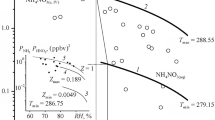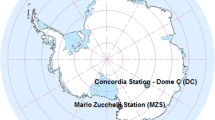Abstract
The effect of positively and negatively charged air ions on aerosols of SERRATIA MARCESCENS was evaluated by comparing rates of exponential bacterial decay. Ions of both polarities were responsible for significant increases in the mean exponential decay rates when compared with a non-ionized ambient atmosphere. Negative ion atmospheres were shown to be slightly more active than positive ion atmospheres,which is probably due to a greater biological action of negative ions.
Zusammenfassung
Die Wirkung von positiven und negativen Luftionen auf SERRATIA MARCESCENS aerosole wurde untersucht. Im Vergleich zu nicht ionisierter Luft führte Luft mit positiven und negativen Ionen zu einem signifikanten Anstieg der exponentiellen Absterberate. Negativ ionisierte Luft war etwas wirksamer als positiv ionisierte' Luft. Dies ist wahrscheinlich Ausdruck der stÄrkeren biologischen Wirkung der negativen Ionen.
Resume
Les effets d'une ionisation positive ou négative de l'air ont été étudiés sur la vitesse de décroissance d'activité bactérienne dans des aérosols de SERRATIA MARCESCENS. Comparés à des atmosphères non ionisées, les ions des deux polarités ont augmenté cette vitesse, les ions négatifs s'avérant légèrement plus actifs que les ions positifs, ce qui semblerait traduire une plus forte activité biologique des ions négatifs.
Similar content being viewed by others
References
DAVIS, F.K., Jr. and SPEICHER, R.P. (1962): “Natural ion levels in the city of Philadelphia”. Proc.Int.Conf. on Ionization of the Air. Am. Inst.Med.Climatology, Philadelphia, I: 1–16 (XI).
DAVID, T.A., MINEHART, J.R. and KORNBLUEH, I.H. (1960):“Polarized air as an adjunct in the treatment of burns”. Am.J.phys.Med., 39: 111–113.
KORNBLUEH, I.H. (1958): “Brief review of effects of artificial ionization of the air and ultraviolet radiation”. Int.J.Bioclim.Biometer., 2 : part 4, Section Coe.
KORNBLUEH, I.H., PIERSOL, G.M. and SPEICHER, F.P.: “Relief from pollinosis in negatively ionized rooms”. Am. J. phys. Med., 37 : 18–27.
KRUEGER, A.P. (1962): “Air ions and physiological function”. J. gen. Physiol., 45: 233–241.
KRUEGER, A.P. and SMITH, R.F. (1957): “Effect of air ions on isolated rabbit trachea”. J.exp.Biol.Med., 96: 807–809.
KRUEGER, A.P. and SMITH, R.F. (1958a): “Effect of gaseous ions on tracheal ciliary rate”. J.exp.Biol.Med., 98: 412–414.
KRUEGER, A.P. and SMITH, R.F. (1958b): “The effect of air ions on the living mammalian trachea”. J.gen.Physiol., 42: 69–82.
KRUEGER, A.P. and SMITH, R.F. (1959): “Parameters of gaseous ion effects on the mammalian trachea.A.Duration of effects. B. Minimal effective ion densities”. J.gen.Physiol., 42: 959–969.
KRUEGER, A.P., SMITH, R.F. and GO, I.G. (1957): “Action of air ions on bacteria”. J.gen.Physiol., 41: 359–381.
KRUEGER, A.P., SMITH, R.F. and MILLER, J.W. (1959): “Effects of air ions on trachea of primates”. Proc.Soc.exp.Biol. (N.Y.), 101: 506–507.
KRUEGER, A.P., SMITH, R.F., HILDEBRAND, G.J. and MEYERS, C.E. (1959): “Further studies of gaseous ion action on trachea”. Proc.Soc.exp.Biol. (N.Y.), 102: 355–357.
McDERMOTT, W. (ed.) (1961):”Conference on airborne infection”. Bact.Rev., 25:1–377.
RUHNKE, L.H. (1962): “The change of the small ion density due to condensation nuclei and the relation to the extinction coefficient of light”. Proc.Int.Conf.on Ionization of the Air. Am.Inst. Med.Climatology, Philadelphia.
SLOTE, L. (1962): “An experimental evaluation of man's reaction to an ionized air environment”. Proc.Int.Conf.on Ionization of the Air. Am.Inst.Med.Climatology, Philadelphia,II, 1–22(XV).
WHITBY, K.T. and McFARLAND, A.R. (1962): “The decay of unipolar small ions and homogeneous aerosols in closed spaces and flow systems”. Proc.Int.Conf.on Ionization of the Air. Am.Inst.Med.Climatology, Philadelphia, 1: 1–30 (VII).
WILSON, C.T.R. (1899): “On the comparative efficiency as condensation nuclei of positively and negatively charged ions”. Phil. Trans.A., 193: 289–308.
WORDEN, J.L. (1954): “The effects of air ion concentration and polarity on the carbon dioxide capacity of mammalian blood plasma”. Fed. Proc., 13: 557.
WORDEN, J.L. (1961): “Proliferation of mammalian cells in ion-controlled environments”. J.Nat.Cancer Inst., 26: 801–811.
WORDEN, J.L. and THOMPSON, J.R. (1956): “Air ion concentration and the growth of cells in vitro”. Anat.Record, 124: 500.
Author information
Authors and Affiliations
Rights and permissions
About this article
Cite this article
Phillips, G., Harris, G.J. & Jones, M.W. Effect of air ions on bacterial aerosols. Int J Biometeorol 8, 27–37 (1964). https://doi.org/10.1007/BF02186925
Received:
Issue Date:
DOI: https://doi.org/10.1007/BF02186925




